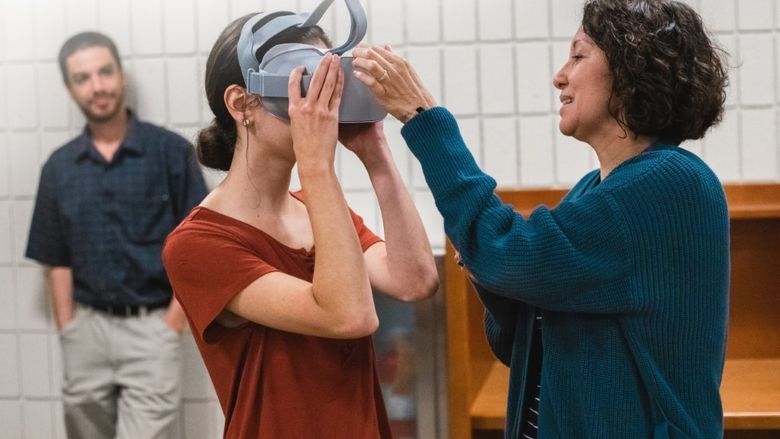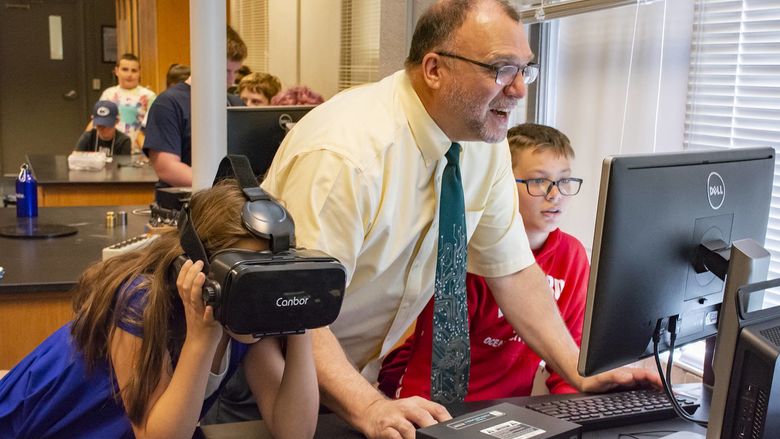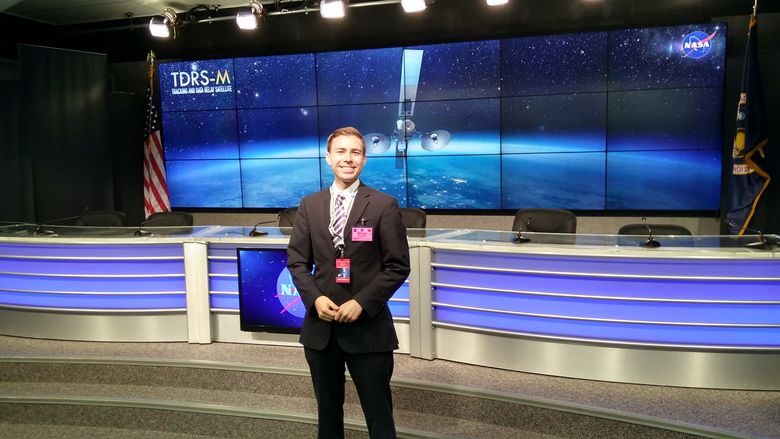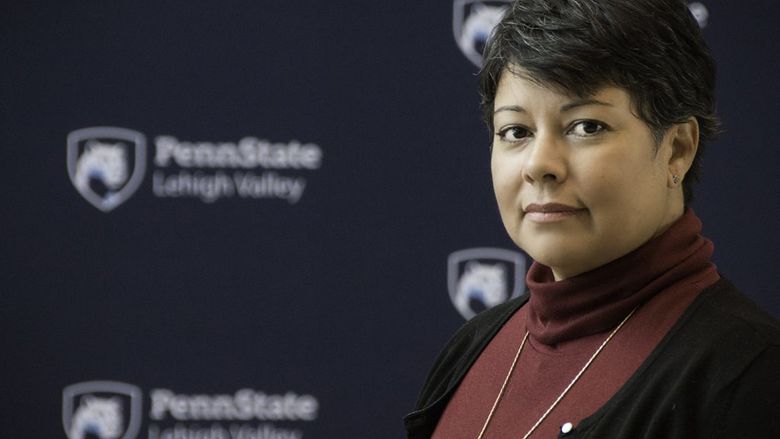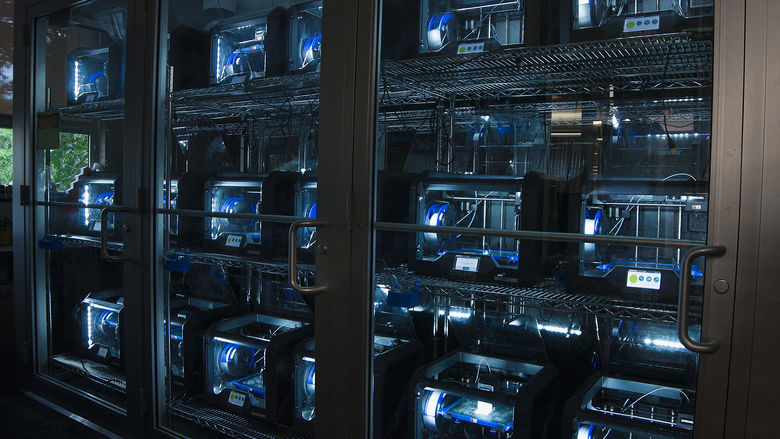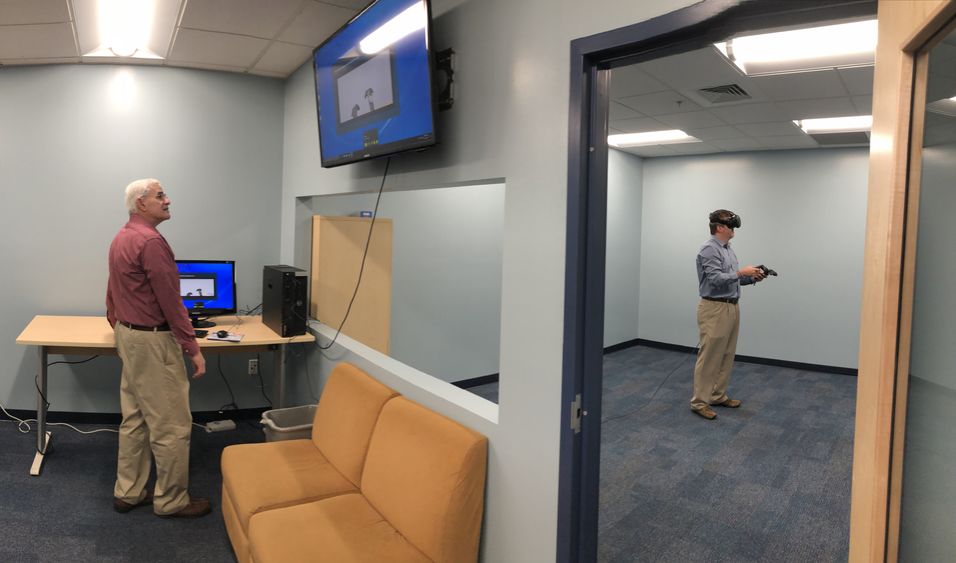
Todd Retzlaff, assistant professor of mathematics at Penn State Lehigh Valley, becomes acquainted with the VR goggles in the new room. He hopes to test CalcFlow, a virtual reality calculus experience. Campus instructional designer Dean Shaffer stands by to assist.
Virtual reality is helping to break the barriers that exist when in-person, hands-on learning is impractical or impossible in higher education.
Faculty at Penn State Lehigh Valley will be exploring the benefits of the immersive technology for their students over the coming months in a new virtual reality room nearing completion on campus.
The project had its genesis in a challenge presented to the class of 2020 by Chancellor Tina Q. Richardson, who invited first-year students to reimagine the relatively new campus building and help make it a better, more creative learning environment. They called the project Metamorphose.
While the students participating in the creative learning challenge suggested many great project ideas, including an outdoor learning space and a mosaic staircase, bringing a virtual reality space to the campus was one idea that really stood out.
Kate Morgan, director of virtual education at the Lehigh Valley campus, has been spearheading efforts to open a virtual reality room and was among seven faculty and staff members who facilitated Metamorphose.
“We all realized that this generation of learners is very different than those in the past: Classroom experiences are much different, there's a lot more active learning, and they have higher expectations about internships and group projects,” said Morgan.
Staff at Penn State Teaching and Learning with Technology (TLT), whose Dreamery inspired the space, assisted by sharing their experiences with deploying immersive reality technologies. The Dreamery, located in the Shields Building on the University Park campus, is a co-learning space where students, faculty, and staff can explore emerging technologies.
“Supporting virtual reality from scratch can be an intimidating prospect,” said Chris Stubbs, TLT manager of emerging technology and media. “Our own experimentation over the past few years has taught us a lot, and the more of that we can share, the easier it is for our partners to help bring the power of immersive experience technologies to students across the commonwealth.”
Renovations of the space at Lehigh Valley, which started over the summer, involved reimagining a Mac lab. The project had a budget of approximately $8,000, and funding came from multiple sources, including the campus and student fee committee.
The space is essentially two 15-by-15-foot rooms, separated by a giant window without glass. One room is for those who are experiencing virtual reality, complete with chairs, two headsets and a computer as a viewing platform to select the experience. In the other room, students or faculty can speak with the individual getting the VR experience and observe what he or she is seeing on a TV screen.
As soon as the final pieces of furniture arrive, the VR room will be ready for use.
Morgan said at least 10 faculty members have expressed an interest in incorporating the immersive technology into their courses, such as chemistry, physics, astronomy, art history, history, biology, and Spanish. Some VR apps they are considering include: CalcFlow for physics and math courses, Star Chart for astronomy, VR Museum of Fine Art for art history and arts administration, Stonehenge for art history and travel, and VR Terra Cotta Warriors for history.
“Physical, hands-on participatory engagement with learning material has historically been the domain of residential experiences,” said Stubbs. “There are tremendous benefits to that kind of learning, but it can be expensive, difficult to repeat, and demands that the learner be in a specific place at a specific time in order to enjoy, assuming of course it is possible at all. VR removes those constraints, which opens up incredible opportunities for learning at scale, anywhere in the world.”
To explore ways to use virtual reality to enhance teaching and learning, contact TLT at [email protected].
